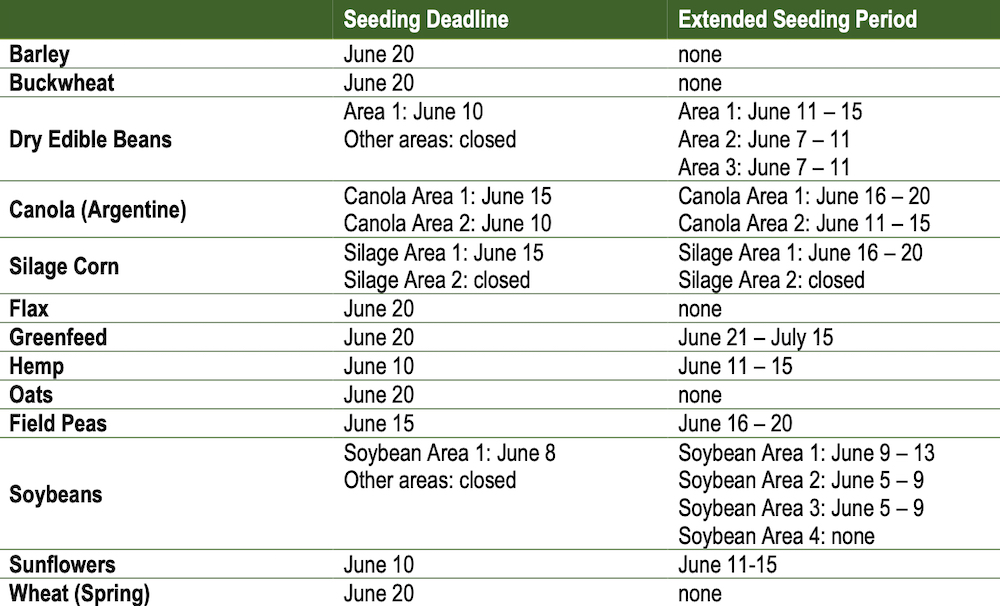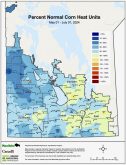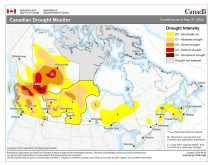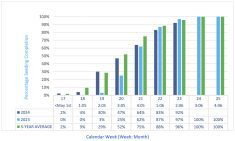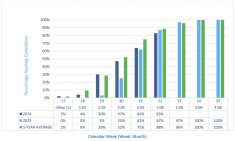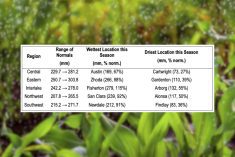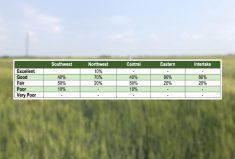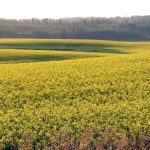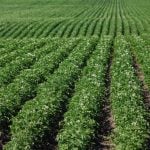Overview
Widespread, heavy rains began last week, forcing a stop to all field activities until this weekend, with the exceptions of the Northwest and much of the Southwest region, which saw significant increases in seeded acreage. The following days were dry, windy and cool, warming up over the weekend when many farmers were able to continue field preparations for seeding.
Producers switching between seeded crops has been the norm, taking time to recalibrate seeding equipment and move operations is slowing progress, but overall growers are very mindful of picking their driest fields and seeding whatever was intended for that land as soon as they are able. High weed pressure as a result of an abundance of moisture has many growers attempting to spray where they can, but prioritizing land preparation and seeding tasks to meet seeding deadlines on remaining crops (see chart at top).
Read Also
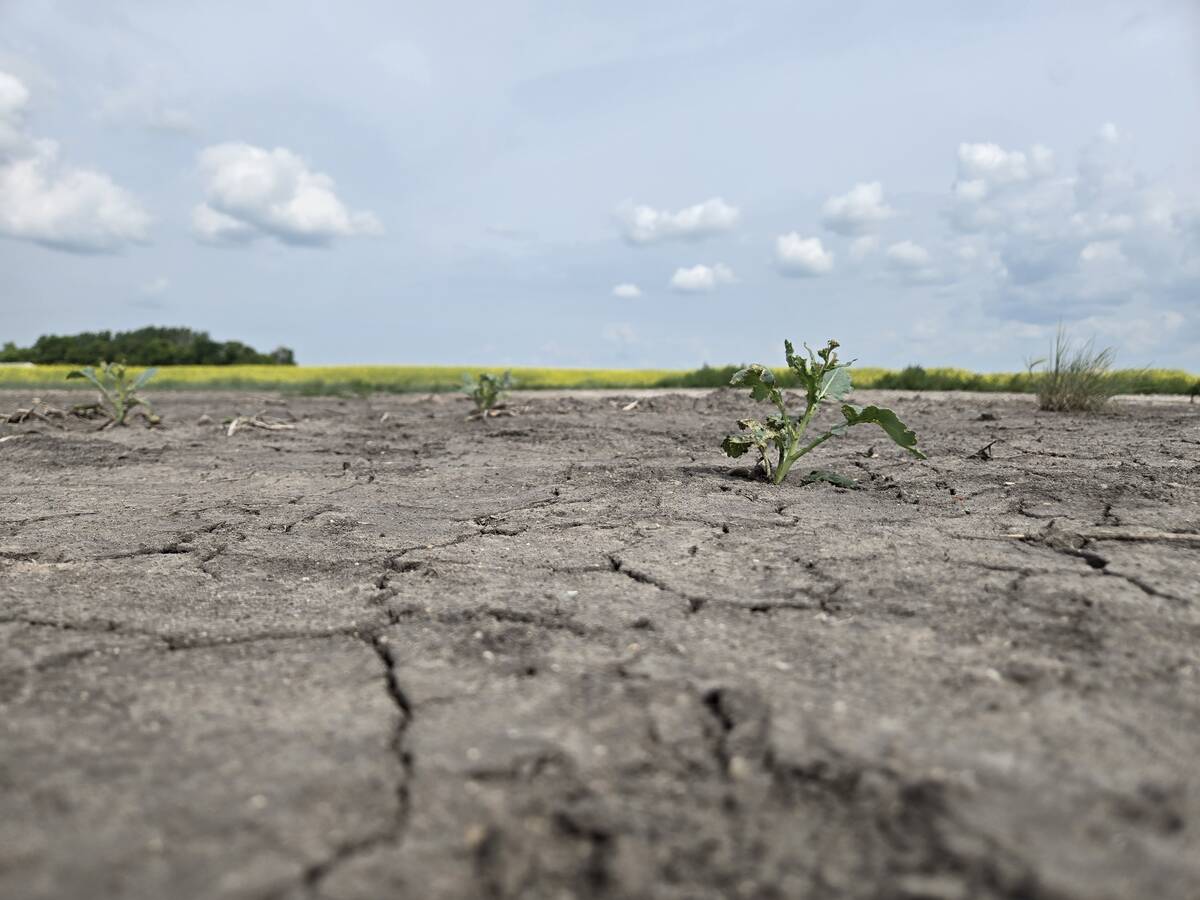
Manitoba crops suffer drought signs
Lack of grain fill, short crops and premature ripening are starting to show up in Manitoba fields where little rain has fallen since the start of May.
Shifting acreage from corn, soybean, and some sunflower crops to canola, wheat, oats, and barley has caused supply constraints at retailers. Fertilizer supply is sufficient, but canola seed may not be, or retails have trouble sourcing enough seed and chemical to cover off new canola or cereal acres. Farmers are encouraged to speak with their agronomist, retailer, chemical representative, and custom applicator as soon as possible to mitigate issues.
Manitoba farmers’ outlook for 2022 has been discouraged by poor weather, logistic delays, and extreme commodity risk. Farmers, livestock producers, ag-retailers and support networks are encouraged to connect with each other, and reach out to counselling and stress support services as needed.
Cereals
Spring cereal seeding is nearly 80% complete in all regions, and earliest seeded crops are now at the 2 to 3-leaf stage, and covering ground quickly.
Kochia and green foxtail weeds have quickly risen to problem status this spring, rapidly emerging and in thick patches in many fields, along with volunteer canola, round-leaf mallow, and wild buckwheat.
Corn planting is complete. Crop insurance deadlines for grain corn have passed, unplanted corn acres have shifted into canola or wheat.
Cool overnight temperatures have slowed corn emergence, the earliest fields now growing into the first true leaf. Very few cutworm issues reported.
Fall rye looks excellent across the province, with lush growth. Winter wheat has only a few drowned out spots with the excessive moisture.
Oilseeds
Canola emergence was rapid on fields planted last week, with crops out of the ground in less than 10 days if they were not flooded.
Approximately 35 to 60% of canola fields have been planted in all regions, with a large number of acres being floated on.
Heavy rains have left fields with lower surface residue crusted as they dried, necessitating some reseeding of canola in patches or whole-fields where germinating seedlings were unable to break through. A light rain is necessary to soften field surfaces soon or reseed acres will increase.
A light frost has forced some reseeding in localized areas in the Southwest and Northwest regions.
Foliar application for flea beetles has started in a number of canola fields, using permethrin as the active ingredient of choice. Flea beetle damage ranges from moderate to severe, depending on district.
A substantial increase in canola acres is expected, given the number of soybean and corn acres dropped due to late planting concerns. Retailers have noted that canola seed supply for switched-acres is rapidly declining, while some seed may be left for reseed if necessary.
Broadcast-seeded canola crops have not yet emerged.
Broadcast or aerial seeded canola must be incorporated via mechanical means on or before the seeding deadline, and must fully establish in order to be eligible for AgriInsurance.
Flax and sunflower crops are mostly seeded, and emerging sunflower crops appear in good condition.
Less flax than intended has been sown to date, given the crop’s flexibility for later seeding dates.
Contracting opportunities for sunflowers may encourage a few later-seeded crops up to the June 15th
extended coverage deadline.
Pulses
Soybean crops have mostly been planted, and any further acres left to be planted will likely be switched to canola or wheat, with some growers choosing barley or oats as a greenfeed alternative. Soybean planting across the province sits between 70 to 80% of the intended 1.3 million acres in Manitoba.
Cool overnight temperatures have slowed soybean emergence, and most fields remain below ground, with ground crack just starting on the earliest fields.
Field pea crops range from emergence to 4th node stage, and many are ready for in-crop herbicide application. Peas are not expected to have challenges posed by crusted soils.
Farmers are switching out of yet-unplanted soybeans into canola or wheat, a number of seeding deadlines have already passed.
Forages & Livestock
Forages
Forages are responding to recent warmer daytime temperatures well, and growing rapidly.
Strong winds earlier last week have inundated pastures and hayfields along lakeshores, and will remain unusable for an extended period of time.
Nearly all regions of the province remain short on feed supplies, resulting in cattle being sent to pasture
earlier than desired, with many pastures in fragile condition after overgrazing last year.
Livestock
Most cattle have been turned out to pasture, and yards have been drying up with sunnier days.
All creeks, streams, dugouts, and sloughs have refilled to capacity, and generally remain within their banks, but water levels remain high.
Regional Comments
Southwest
Weather has been cooperative for seeding progress in the region, despite a few windy days. Mornings and evenings have been relatively calm, allowing for some herbicide and insecticide application. Some farms are skipping pre- emergent herbicide application to focus on getting the crop in. Seeding progress is now 65% complete. Districts north of the TransCanada Highway are slightly further ahead than areas further south, which are still struggling with poor field conditions caused by heavy rains last week.
Northwest
Better weather spurred seeding progress across the region, while rain slowed planting on the eastern side of the region to begin last week. A light frost arrived over the weekend, with small amounts of damage on cotyledon canola in the Swan River Valley. Wind damage was evident in some wheat crops.
Soybean planting is complete in the region, as are most field pea acres. The earliest pea fields have emerged. Seeding progress varies, from 65 to 70% done near Roblin and Swan River, while nearly done at The Pas. Dauphin- Ste. Rose was about 40% complete, up 20% from last week.
Central
Planting resumed across the region late in the weekend and Monday, after standing still for nearly a week following last Monday’s rainstorm. Planting progress is highly variable, areas west of the escarpment and near major waterways is slower to resume, while progress has been good in western parts of the Red River Valley south of PTH 3. Land north of Austin to Gladstone remains very wet, and some planted fields have been flooded for more than two days, and will result in large drowned-out spots. Seeding completion across the region has reached 70%, with lower amounts seeded near Gladstone, Altona, and along the Red River.
Heavy harrowing fields is a necessity for most fields in the region, to dry them and kill some weed seedlings ahead of planting or to incorporate broadcast fertilizer. Green foxtail emergence has been thick in many fields, resulting in a push to spray pre-emergence on later-seeded crops and potatoes.
Eastern
Good winds and warmer temperatures helped fields dry out for planting to resume this weekend, but drying remained limited to the surface, with mud just underneath. Very little seeding progress occurred during the past week, leaving regional seeding progress sitting at 60% complete, with areas east of Morris through Arnaud and Emerson nearing 90%. Most remaining fields are expected to be planted this coming week, but a few will not be seeded this year. Retails have reported higher returns and order cancellations of corn, sunflowers, and some soybeans.
Interlake
Tillage and seeding resumed early this week, following last Monday’s heavy rains. The region sits at an estimated 50% complete, with considerable variation between districts and farms. Many farmers have been leaving potholes and wet areas in attempts to seed as much as possible, perhaps return at a later date. Standing water is still evident.
The rural road network in the Interlake is in very poor condition, with many roads rutted and muddy. Washouts from the spring melt remain unrepaired, hampering farmer access to fields and pastures and forcing lengthy detours adding time and cost to already delayed operations.





